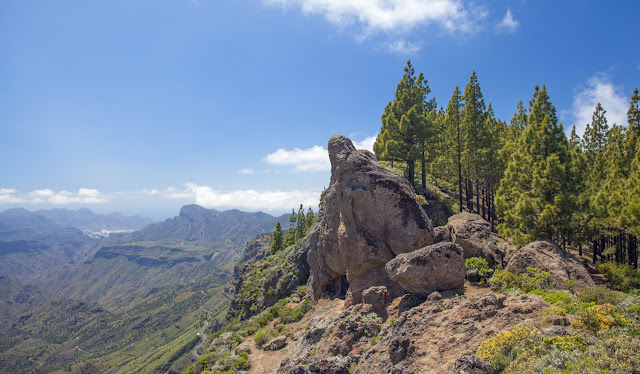 |
| Panorama taken from the top of the Risco |
We came to the place to check out if Tanacetum ptarmiciflorum, the silver lace plants, have started to bloom yet. They have not, but their silvery leaves are beautiful as ever.
The species is listed as endangered, and is endemic to Gran Canaria. The Red List points out five known location, mentioning that the earlier reported site at Cuevas de Caballero was not found during the 2009 survey. I am not sure if the location we came to see was the one they mispaced. Maybe, or maybe not, since one of the locations that are confirmed is vaguely described as "Tejeda" (village? municipality? o que?).
 |
| Tanacetum ptarmiciflorum, silver lace, silver feather. I myself like to call it silver tansy |
Anyway, I guess I'd like to stress at this point that the plant is endangered and please don't pick up bunches or trample over them. They are joy to behold in any case. I do hope to catch the time of bloom, and then I'll add more pics.
And now for something completely different: the stone face :)
 |
| The "door" to the caves |
I went past the sign for "Cueves de Caballero" many times, but the drop always looked somewhat intimidating and I never went down to explore till two weeks ago. I finally mustered my courage - and discovered I didn't really need it after all. If you look between the two rocks around the entrance (above), it looks like a sheer drop down, but come closer and you'll see the situation is not as bad as all that - there is a wide ledge/small plateau at maybe three meters below. The way down to it is steep, but the stones are rough and eroded, providing good grip. Actually, once I was down on the ledge, I realized there is even a semblance of small stone stairs, invisible from the top because there is virtually no shade. So, long as the stones are dry, you'll be fine. Don't go down there if it was raining though - the drop to the ledge is big enough to break something important if you slip.
The entrances to the main caves are made ugly and barred by iron grid doors (apparently there are keys held by some mythical guides, but I don't know how to contact them and how much they charge for the privilege to enter). Through the bars, and after waiting some for your eyes to get used to the gloom, you can see the interiors of the caves.
According to the information provided by Cabildo the caves are interesting chiefly because of scratched graffiti on their walls. The relief of the scratches is low, so it was difficult to see much from the outside, but you can find some photos taken from inside here. The main motif seems to be female pubic triangle. We managed to identify one of them from the outside. I am not sure if I feel particularly enriched by this experience, but at least it does show that the subjects of graffiti didn't change much through the ages or cultures.
 |
| The view from the ledge down into the caldera is vertiginous. Check out those roads. I don't like them. |
First time I went down to the caves, I went alone. Second time, Kirill was with me, and it was he who spotted the stone face.
 |
| As you can probably see, it is not that visible from the top. But I missed it even when being on the ledge, maybe because I didn't really expect to find it |
My original assumption was that this is something new, because aboriginal sculpture couldn't possibly be in such a nice condition, it looks like it was relatively recently cleaned of the lichen and possibly re-sculpted in process. Plus, the official cave info doesn't mention it, so... But, to be on the safe side, I asked a question in a relevant(ish) group on facebook and got a few answers, ranging from "nonono, it is made by pre-spanish aboriginal dwellers and it is a portrait of some local king or something" to "it was made by a German hippy who lived in the caves at some point". To me, the latter version seems more likely than the former.
Having said that, it is nice to look at and something curious to find. Blends nicely into the landscape and looks almost authentic. Hippies of the world, unite and make some more, why don't you? Maybe choose some other spot though, less archaeologically significant.
 |
| Rock formation in the top of the caves. You can see the entrance to one of the caves under the tallest rock at big resolution (click on the image to increase) |
There is about 3.6 kilometers between Cruz de Tejeda and Cuevas de Caballero, i.e. they are about halfway down the path to Artenara. There is a steep but short ascent at the beginning of the route if you start from Cruz de Tejeda. Once you saw the caves and the plants, you can carry on to Artenara. Check the bus schedule though, there is just one bus from Artenara to Teror in the afternoon, AFAIK.
 |
| Beautiful cirrus on the way back :) |
Pictures of Gran Canaria on shutterstock - here
Text and photos by Tamara







No comments:
Post a Comment